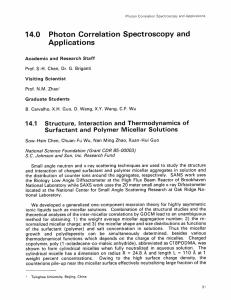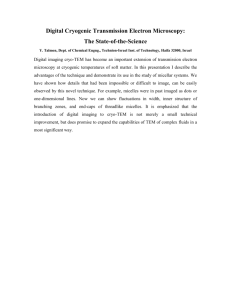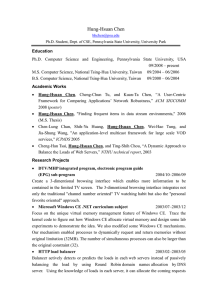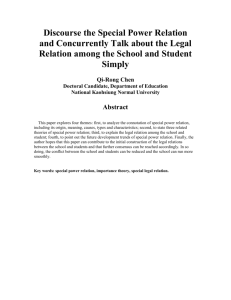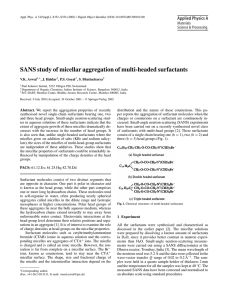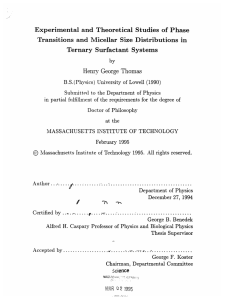14.0 Photon Correlation Spectroscopy and Applications
advertisement
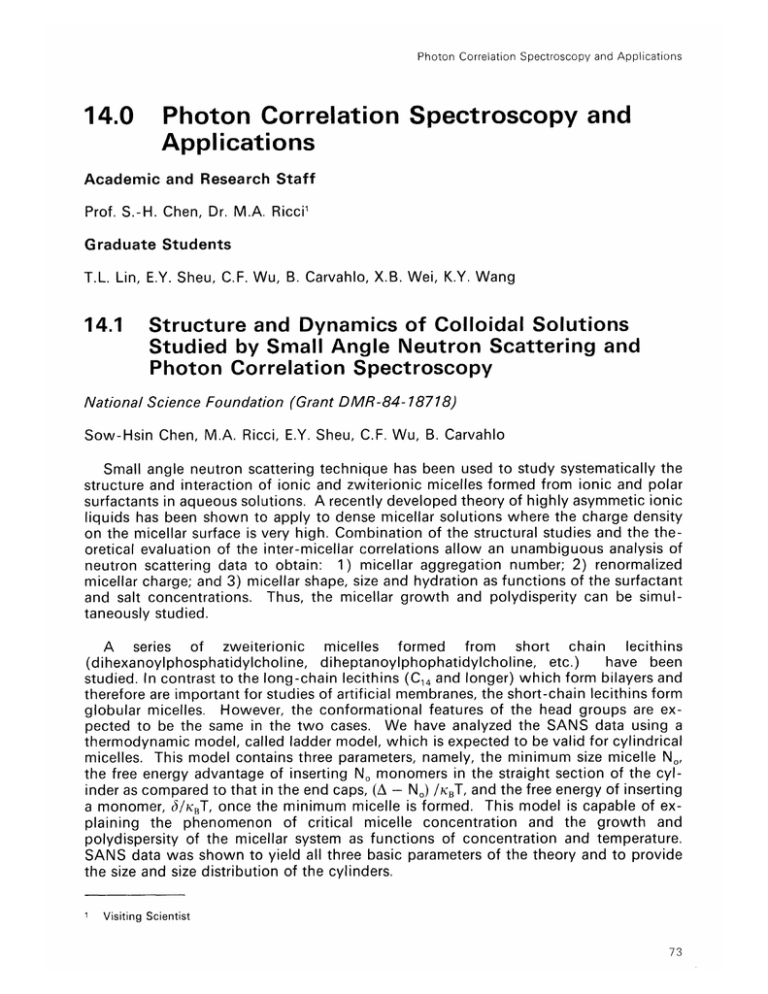
Photon Correlation Spectroscopy and Applications 14.0 Photon Correlation Spectroscopy and Applications Academic and Research Staff Prof. S.-H. Chen, Dr. M.A. Ricci' Graduate Students T.L. Lin, E.Y. Sheu, C.F. Wu, B. Carvahlo, X.B. Wei, K.Y. Wang 14.1 Structure and Dynamics of Colloidal Solutions Studied by Small Angle Neutron Scattering and Photon Correlation Spectroscopy National Science Foundation (Grant DMR-84- 18718) Sow-Hsin Chen, M.A. Ricci, E.Y. Sheu, C.F. Wu, B. Carvahlo Small angle neutron scattering technique has been used to study systematically the structure and interaction of ionic and zwiterionic micelles formed from ionic and polar surfactants in aqueous solutions. A recently developed theory of highly asymmetic ionic liquids has been shown to apply to dense micellar solutions where the charge density on the micellar surface is very high. Combination of the structural studies and the theoretical evaluation of the inter-micellar correlations allow an unambiguous analysis of neutron scattering data to obtain: 1) micellar aggregation number; 2) renormalized micellar charge; and 3) micellar shape, size and hydration as functions of the surfactant and salt concentrations. Thus, the micellar growth and polydisperity can be simultaneously studied. A series of zweiterionic micelles formed from short chain lecithins have been (dihexanoylphosphatidylcholine, diheptanoylphophatidylcholine, etc.) bilayers and which form studied. In contrast to the long-chain lecithins (C14 and longer) therefore are important for studies of artificial membranes, the short-chain lecithins form globular micelles. However, the conformational features of the head groups are expected to be the same in the two cases. We have analyzed the SANS data using a thermodynamic model, called ladder model, which is expected to be valid for cylindrical micelles. This model contains three parameters, namely, the minimum size micelle No, the free energy advantage of inserting No monomers in the straight section of the cylinder as compared to that in the end caps, (A - No) /KBT, and the free energy of inserting a monomer, 6/KT, once the minimum micelle is formed. This model is capable of explaining the phenomenon of critical micelle concentration and the growth and polydispersity of the micellar system as functions of concentration and temperature. SANS data was shown to yield all three basic parameters of the theory and to provide the size and size distribution of the cylinders. 1 Visiting Scientist Photon Correlation Spectroscopy and Applications A high resolution spectroscopic technique based on analyses of scattered light intensity fluctuations has been in use for some time. Our method is based on the digital time-domain pulse correlation technique using a 256-channel clipped correlator developed in the laboratory. The correlator-multichannel memory system is controlled by a PDP 11/MINC computer system which is capable of high-speed data acquisition and analysis necessary for the study of time-varying phenomena. We have applied this photon correlation technique to study the Brownian dynamics of strongly interacting colloidal systems. Interesting results on the variation of mutual diffusion coefficient of the micellar solutions with addition of salts and alcohol have been observed. Publications Bratko, D., H.L. Friedman, S.-H. Chen, and L. Blum, "Intrepretation of the Intermicellar Structure Factors in the Hypernetted-chain Percus-Yevick Approximation," Phys. Rev. A 34, 2215 (1986). Chao, Y.S., E.Y. Sheu, and S.-H. Chen, "Experimental Micelles," J. Phys. Chem. 89, 4862 (1985). Test of a Theory Dressed Chao, Y.S., E.Y. Sheu, and S.-H. Chen, "Intermicellar Interactions in Lithium Dodecyl Sulfate Solutions, Effects of Divalent Ions," J. Phys. Chem. 89, 4395 (1985). Chen, S.-H., "Interactions and Phase Transitions in Micellar and Microemulsion Systems Studied by SANS," Physica 137B, 183 (1986). Chen, S.-H., "Small Angle Neutron Scattery Studies of the Structure and Interaction in Micellar and Microemulsion Systems," Ann. Rev. Phys. Chem. 37, 351 (1986). Chen, S.-H. and J.S. Huang, "Dynamic Slowing-down and Nonexponential Decay of Density Correlation Functions in Dense Microemulsions, " Phys. Rev. Lett. 55, 1888 (1985). Sheu, E.Y., C.F. Wu, S.-H. Chen, and L. Blum, "Application of a Rescaled Mean Apherical Approximation to Strongly Interacting Ionic Micellar Solutions," Phys. Rev. A 32, 3807 (1985). Sheu, E.Y., C.F. Wu, and S.-H. Chen, "Effects of Ion Sizes on the Aggregation and Surface Change of Ionic Micelles in 1:1 Electrolytes," J. Phys. Chem. 90, 4179 (1986). 14.2 Basic Studies of Laser-Cell Interactions Wan-Yuan Company, Beijing, Peoples Republic of China Contract Sow-Hsin Chen, X.B. Wei, X.Y. Wang An instrument consisting of a copper vapor laser coupled to an optical fiber/chemical injector catheter for the treatment of occluded arteries has been constructed and tested. 74 R.L.E. P.R. No. 129 Photon Correlation Spectroscopy and Applications The combined application of three steps: the pre-irradiation injection of a light absorbing dye, HPD, brief copper laser irradiation (at 578 nm), and a urokinase infusion after the irradiation, produced the striking effect of liquification and resolution of thrombus. The histological examination of the arteries after the treatment showed no apparent damage of the arterial wall. Publication Wei, X.B., X.Y. Wang, and S.-H. Chen, Catheter System for Liquification Arteries." Sent to Lasers in Surgery Laser Angiosurgery," to be published "A Copper Vapor Laser and Optical Fiber and Removal of Thrombus in Occluded and Medicine. "Method and Apparatus for in 1987. ~,,~~, CT '" ia:.,;i 76 R.L.E. P.R. No. 129

